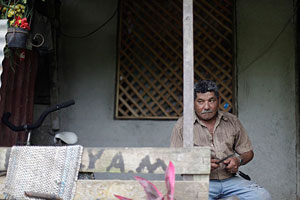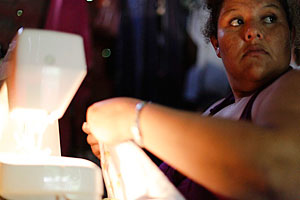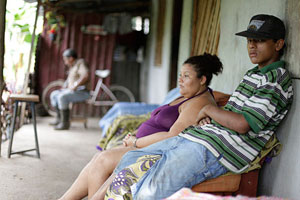
The effects of the global crisis on Nosara can be applied to an in-depth analysis of the area’s development. Many Nosareños, as did thousands of Guanacastecos, were forced to rapidly adapt to changes in both the job market as well as their lifestyle. The spotlight shifted from agriculture to tourism and the construction industry, which depend largely on foreign investment and where the well-paid jobs are few. In addition, these demand a level of education to which the Nosareño has not been able to adjust.
However, the community’s social forces are hard at work, paving the road for a better future.

Rosalino Acosta Acosta |
|
Guiones – Rosalino Acosta Acosta, 61, of Nosara, was whetting his machete in front of his house, which is located in Santa Teresa neighborhood, on a Friday afternoon. He has been spending his days trying to find things to keep himself busy. Jobless for more than one month now, he has six mouths to feed in his house.
Similarly, Rosalino’s 30 year-old, pregnant daughter, Marianela Acosta Lopez, is jobless for more than five months. She used to work in a local restaurant. As the business went down with global economical crisis, they cut down the number of staff. As a pregnant woman, it is very hard for her to find a job, however, she commented that, “English and education are what they look for. And because I don’t have any education, even if I weren’t pregnant, it would be difficult to find a job.”
The statistics of Instituto Nacional de Estadística Y Censos (INEC) for 2008 show the Guanacaste province with 25.733 people at extreme poverty making Guanacaste the poorest of all country. The Guanacaste unemployment rate from 2009 to 2010 doubled from 5% to 10%, which is higher than the unemployment rate of the entire country, which is 7.8% .
Based on a research done by INEC, Guanacaste had the largest percentage of poor housing at approximately 18% in 1973 and in 2007, this region still held the highest percentage in the nation. The numbers have not changed for the last 34 years.
The situation is complicated because last year the number of tourists that came to the area fell. In Northern Guanacaste, the numbers decreased from 25% to 17%, and in the south the numbers decreased from 6% to 5%. With this overview the GUANCASTE CHAMBER OF TOURISM (CATURGA) asked for a plan of financial support and more aid from the government. |
| |
|

Rosalino Acosta Acosta |
|
| |
|
 |
|
THE HISTORY OF NOSARA
“Originally, Nosara (He doesn’t really mean “Nosara” here. He means the beach front community known as the North American project. You don’t identify who this man is, but I think he’s got the history wrong. I have always understood it to be 7 cattle ranches totaling many fewer than 3.000 acres. And, while the property owners association is called the NCA, that is NOT the name of the “American Project.”)was made up of five or six large ranches. Three of these ranches were purchased in the early 70’s, totaling nearly 3,000 acres, and would soon become the Nosara Civic Association or better known as the ‘American Project”, Darin McBratney said. Before the arrival of the American Project, livestock breeding and agriculture were the two main economic activities of the Nosara region. Big pieces of land belonged to a few Tico families and the Nosareños were working for these landowners from 5 am to 1 pm; then, they worked with their own little farms and by 6 pm it was bedtime. But later, a rapid shift to construction and tourism sectors occurred.
This sector shift resulted in social changes that the area wasn’t prepared for. Educational opportunities, roads, health and security services were some of those.
Now, tourism and construction are the two main economic activities in the area. According to Terry Von Der Weid, one of the first entrepreneurs who came to Nosara in 1990’s, construction business is the biggest source of income. On the other hand, Maria Elena Paniagua, the president of the Chamber of Tourism in Nosara, thinks that there is a reciprocal relationship between construction and tourism sectors to be the sources of income for everybody in this region.
There are different opinions about the causes of poverty in a rich province. According to Maria Elena Paniagua, there are two main causes in Nosara; unemployment; and lack of high school and university education. She explains the causal relationship with a mimesis (I don’t know what this word means in this context. I’d suggest you use “metaphor” instead). In relation to the effects of the global crisis on the economy of the Guanacaste region, Paniagua said, “It is a domino effect. The global crisis causes less investment or fewer tourists visiting the area, which means fewer job opportunities for locals. Fewer jobs mean more poverty”. Without a pay check coming to a household, there are only a few chances to send children to study. |
|
Dropping out of Nosara Bocas High School 2010
• Beginning of the classes in February: 33 Students
• Beginning of the classes in July: 9 Students
• Average age for dropping out of school: Between 13 and 16
• Causes: According to Arjerie Ajoy, Headmistress of HIgh School, the most important reason is “the lack of support from parents”. When teenagers say that they don’t want to go to school anymore, parents don’t try to change their opinions. Additionally, for teenagers who recently started school, “it is really hard to adapt to the system”, because they are treated like children by their teachers (Teachers are extra cautious about them), whereas the school treats them like “individuals who are responsible for themselves”.
|
The fact that Nosara established its first high school in 2000, explains the issues about education. Before that, students who wanted to continue their study, had to go to Nicoya. Because daily bus trips and lunch costs were too high, many people couldn’t continue their education. Even though the situation is different today, a young sales assistant from Nosara, admitted that she chose not to go to the university. Now she prefers working and making “fast” money over going to school and sacrificing for a better future
Individual stories vary from one extreme to another in Nosara. Rebecca Navarrete, 31, who has a psychology degree from University of Costa Rica in Liberia, was one of those who chose to take the bus trips to Nicoya for her high school education. Today she works in her own real estate business. She said, “Everything is possible to do. You just need to do it. When I started, I didn’t have a penny. I did it all with my salary. Pura Vida is an expression, but some people take it too seriously”.
Agreeing that there is a lack of opportunities for some people, Navarrete thinks that the problem of poverty in Guanacaste is a problem of lack of vision as well as lack of education. She believes that “Personal ambition of the individual is very important to achieve one’s dreams and desires”.
Not being a prime tourist destination, the conditions of the roads in Nosara and the direction of money flow are some of the other issues that affect poverty. Paniagua commented, “The tourists come to the hotels and bring the money to hotels. Hotels are mostly owned by foreigners. In the end the money goes back to where it comes from”.
However, there are positive changes for a better future, too. The Nosara Surfing Foundation, a non profit organization, is actively improving the local schools’ infrastructure by organizing activities to collect funds, which include the schools staff as well as the parents. The Nosara Development Association is creating a “Kids and Adolescent” comittee to help build a community center where kids can use their energy in a healthy way, like playing basketball or skate boarding, instead of being tempted by the easy to get drugs.
The Chamber of Tourism has some promotional and educational projects. As well as trying to promote Nosara as a prime destination. In 2011, they are going to offer some free courses on English, preparation of a hotel room or a table and cooking. Anyone will be able to attend.
Locals still keep some hope for the future of their children. Marianela says, “Whatever sacrifice I need to do to send my kids to school, I will do it. I didn’t study so I pay it back now. I don’t want my children to be in the same situation with me. They will be better”.
|
|
More Regional News
Nicoya Mayor Elections UNED Debate
Candidates expounded proposals and put aside attacks
The plans to solve the problems of garbage, the cemetery and roadway improvements for the canton were the most interesting themes in the debate where all of the candidates promised honest and transparent management. More >
Dengue Mosquitoes Active in Samara and Nicoya
Ministerio de Salud says increase in cases is due to lack of prevention at home
Dr. Oscar Mendez Campos, coordinator of Dengue for the Hospital de la Anexion in Nicoya, confirmed that there have been cases of dengue this year both in Nicoya and Samara, but he hasn’t seen any cases from Nosara so far. Though there haven’t been any deaths from dengue in the area this year, there have been few cases of hemorrhagic fever, the more severe form of dengue, in Nicoya. More >
Travel Between Nosara and Samara to be
Fully Restored
Decentralization Minister: Main bridges will be
ready by Wednesday
Since Monday, machinery and workers from the Ministry of Public Works (MOPT) have been working to restore the land connection between Puerto Carrillo and Samara. Last Wednesday, the Bailey bridge between these two communities collapsed. More >
Nosara Slowly Returns to Normal but Ostional Remains Cut Off
- Marbella's bridge remains closed due to damages, cutting off San Juanillo
- If good weather conditions continue, vehicle access over Río Frío might be restored
Although Rio Rosario is now low enough to be crossed, the mud that has piled up on its sides does not allow any vehicles to go through. Rolf Sommer, owner of Luna Azul Hotel, along with other entrepreneurs from San Juanillo, have organized themselves in order to hire a backhoe to rehabilitate the road. More + Video >
Nosara, Ostional and Puerto Carrillo Isolated
Due to heavy rains that started on Monday November 1, these three communities are isolated. In Nosara, the bridge over river Frio collapsed this Wednesday. In Ostional, the Rosario River has being flooded since Monday, and the bridge that communicates the Torito community with Puerto Carrillo collapsed on Thursday. More >
Providing food, medicine and gasoline
People in Nosara are stocking up on food and gasoline for the coming days in anticipation of a possible failure of the delivery of these products. VON communicated with the supermarkets in the area and everyone agrees that there has been an increase in purchases during the past two days. More >
Nicoya – Audit Report of the Maritime Terrestrial Zone
Mel Gibson Purchased Illegally Registered Property
• Due to the absence of a zoning plan, the concession was wrongfully granted
• Municipalidad must take over the beachfront strip in the Maritime Terrestrial Zone
Unfortunately, Mel Gibson’s troubles don’t end, even when he arrives in Costa Rica. Although he is trying to maintain a low profile while recovering from the recent scandals in which he has repeatedly threatened his ex-girlfriend and mother of his youngest child, documents from an internal audit done by Nicoya’s Municipalidad show that part of the property Gibson bought at Playa Barrigona was illegally registered. More >
Nicoya Mayoral Elections 2010
The Person Behind the Candidate
Five Candidates, Five Interviews
Usually, when referring to an election, the candidate’s promises are the only thing that gets published. In many cases, the media forgets to portray the person within.
In this issue, in preparation for the December 5th elections, the VON presents a series of “intimate” interviews with the five candidates. More >
|
|
|
|

